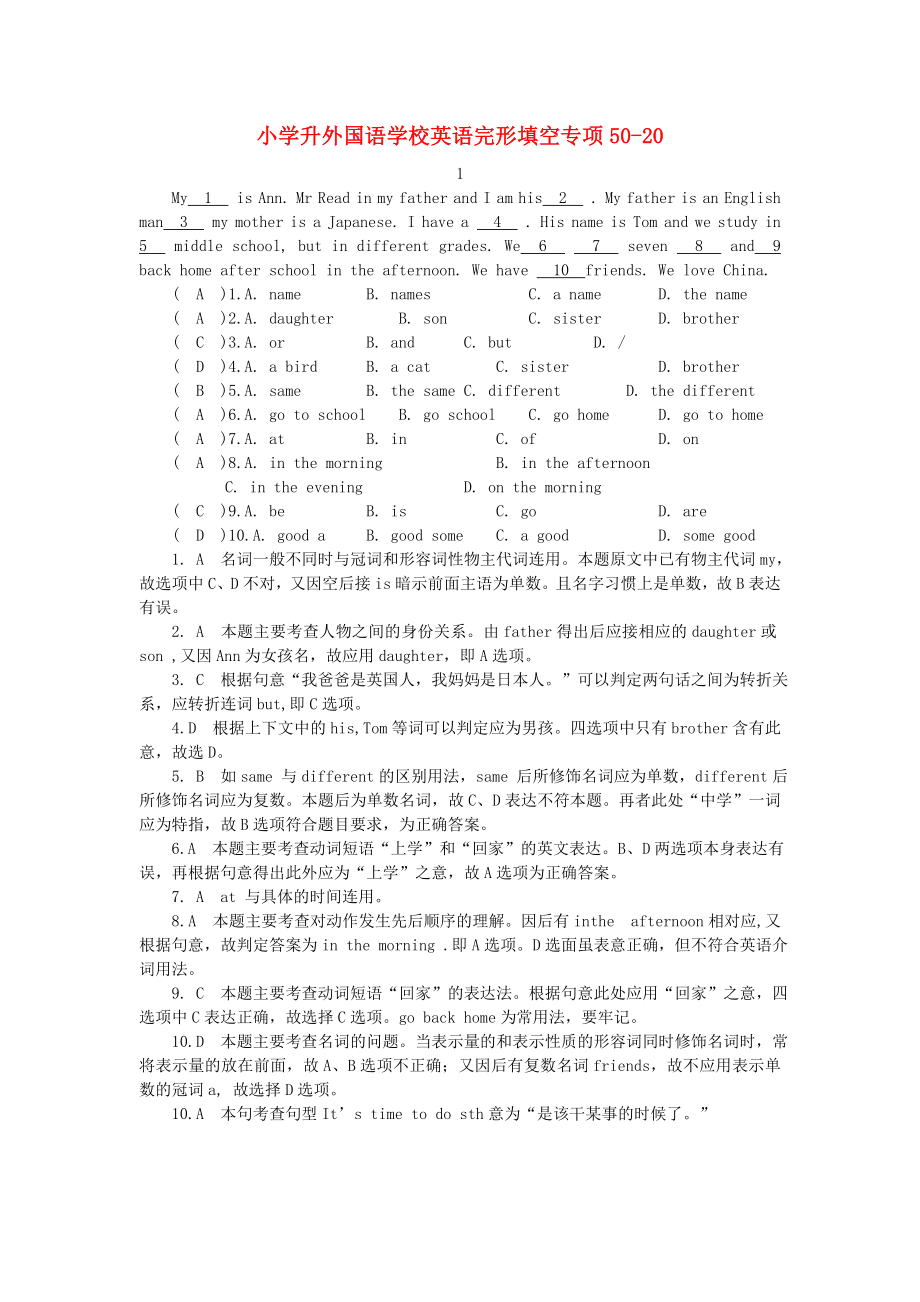《寧夏外國語學(xué)校小升初英語專項(xiàng)訓(xùn)練 完形填空20》由會(huì)員分享�����,可在線閱讀�����,更多相關(guān)《寧夏外國語學(xué)校小升初英語專項(xiàng)訓(xùn)練 完形填空20(2頁珍藏版)》請?jiān)谘b配圖網(wǎng)上搜索�����。
1�����、小學(xué)升外國語學(xué)校英語完形填空專項(xiàng)50-20
1
My 1 is Ann. Mr Read in my father and I am his 2 . My father is an English man 3 my mother is a Japanese. I have a 4 . His name is Tom and we study in 5 middle school, but in different grades. We 6 7 seven 8 and 9 back home after school in the
2�����、 afternoon. We have 10 friends. We love China.
( A )1.A. name B. names C. a name D. the name
( A )2.A. daughter B. son C. sister D. brother
( C )3.A. or B. and C. but D. /
( D )4.A. a bird B. a cat C. sister D. brother
( B )5.A. same B. the same C. different D. t
3�、he different
( A )6.A. go to school B. go school C. go home D. go to home
( A )7.A. at B. in C. of D. on
( A )8.A. in the morning B. in the afternoon
C. in the evening D. on the morning
( C )9.A. be B. is C. go D. are
( D )10.A. good a B. good some C. a good
4、D. some good
1. A 名詞一般不同時(shí)與冠詞和形容詞性物主代詞連用�����。本題原文中已有物主代詞my,故選項(xiàng)中C�����、D不對���,又因空后接is暗示前面主語為單數(shù)�����。且名字習(xí)慣上是單數(shù)���,故B表達(dá)有誤。
2. A 本題主要考查人物之間的身份關(guān)系���。由father得出后應(yīng)接相應(yīng)的daughter或son ,又因Ann為女孩名,故應(yīng)用daughter�,即A選項(xiàng)。
3. C 根據(jù)句意“我爸爸是英國人�����,我媽媽是日本人?����!笨梢耘卸▋删湓捴g為轉(zhuǎn)折關(guān)系��,應(yīng)轉(zhuǎn)折連詞but,即C選項(xiàng)�。
4. D 根據(jù)上下文中的his, Tom等詞可以判定應(yīng)為男孩。四選項(xiàng)中只有brother含有此意�����,故選D�。
5.
5、B 如same 與different的區(qū)別用法�����,same 后所修飾名詞應(yīng)為單數(shù)�,different后所修飾名詞應(yīng)為復(fù)數(shù)。本題后為單數(shù)名詞�,故C、D表達(dá)不符本題����。再者此處“中學(xué)”一詞應(yīng)為特指���,故B選項(xiàng)符合題目要求,為正確答案����。
6. A 本題主要考查動(dòng)詞短語“上學(xué)”和“回家”的英文表達(dá)。B����、D兩選項(xiàng)本身表達(dá)有誤,再根據(jù)句意得出此外應(yīng)為“上學(xué)”之意�����,故A選項(xiàng)為正確答案����。
7. A at 與具體的時(shí)間連用。
8. A 本題主要考查對動(dòng)作發(fā)生先后順序的理解�����。因后有in the afternoon相對應(yīng),又根據(jù)句意���,故判定答案為in the morning .即A選項(xiàng)�。D選面雖表意正確�����,
6����、但不符合英語介詞用法。
9. C 本題主要考查動(dòng)詞短語“回家”的表達(dá)法���。根據(jù)句意此處應(yīng)用“回家”之意����,四選項(xiàng)中C表達(dá)正確�����,故選擇C選項(xiàng)�����。go back home為常用法��,要牢記。
10.D 本題主要考查名詞的問題�����。當(dāng)表示量的和表示性質(zhì)的形容詞同時(shí)修飾名詞時(shí)�����,常將表示量的放在前面�����,故A�、B選項(xiàng)不正確;又因后有復(fù)數(shù)名詞friends�,故不應(yīng)用表示單數(shù)的冠詞a, 故選擇D選項(xiàng)。
10.A 本句考查句型It’s time to do sth意為“是該干某事的時(shí)候了���?����!?
2
Now it’s five 1 .The students are 2 the classr
7�����、oom. And Miss Gao is in the classroom, 3 . She can’t 4 her watch. She asks, “ 5 my watch, please? ” “It’s there, 6 your chair. ”Li Lei answers.
“ Thank you 7 much. What’s 8 ? Let me see, oh, 9 five o’clock. Let’s go 10 now. ” Miss Gao says.
( C )1.A. time B. clock C.
8�、 o’clock D. the clock
( A )2.A. in B. at C. on D. behind
( B )3.A. two B. too C. to D. either(也不)
( D )4.A. know B. look C. have D. find
( C )5.A. Who’s B. Whose C. Where’s D. Where
( B )6.A. in B. under C. of D. after
( A )7.A. very B. too C. every D. to
9�����、
( C )8.A. time B. a time C. the time D. the clock
( A )9.A. it’s B. its C. the time D. time is
( D )10.A. to bed B. to school C. to home D. home
1. C o’clock 表示“整點(diǎn)”��。
2. A 表示在教室里用in
3. B too意為“也”用于肯定句的句尾��。
4. D 根據(jù)下文高小姐問���。
5. C 下文回答了在那兒�����,在椅子下面����,說明本句應(yīng)問地點(diǎn)�。
6. B under為表示地點(diǎn)的介詞,意為“在…下面����?!?
7. A very much用來修飾動(dòng)詞�。
8. C What’s the time? 意為“幾點(diǎn)鐘了?”相當(dāng)于What time is it?
9. A it’s 是it is的縮略形式�����。its意為“它的”是形容詞性物主代詞�。
10.D 五點(diǎn)鐘按常規(guī)應(yīng)是下班回家的時(shí)間,而不是A項(xiàng)(上床睡覺)�����,也不是B項(xiàng)(上學(xué))����。另外home為副詞前面不能要介詞。
 寧夏外國語學(xué)校小升初英語專項(xiàng)訓(xùn)練 完形填空20
寧夏外國語學(xué)校小升初英語專項(xiàng)訓(xùn)練 完形填空20

